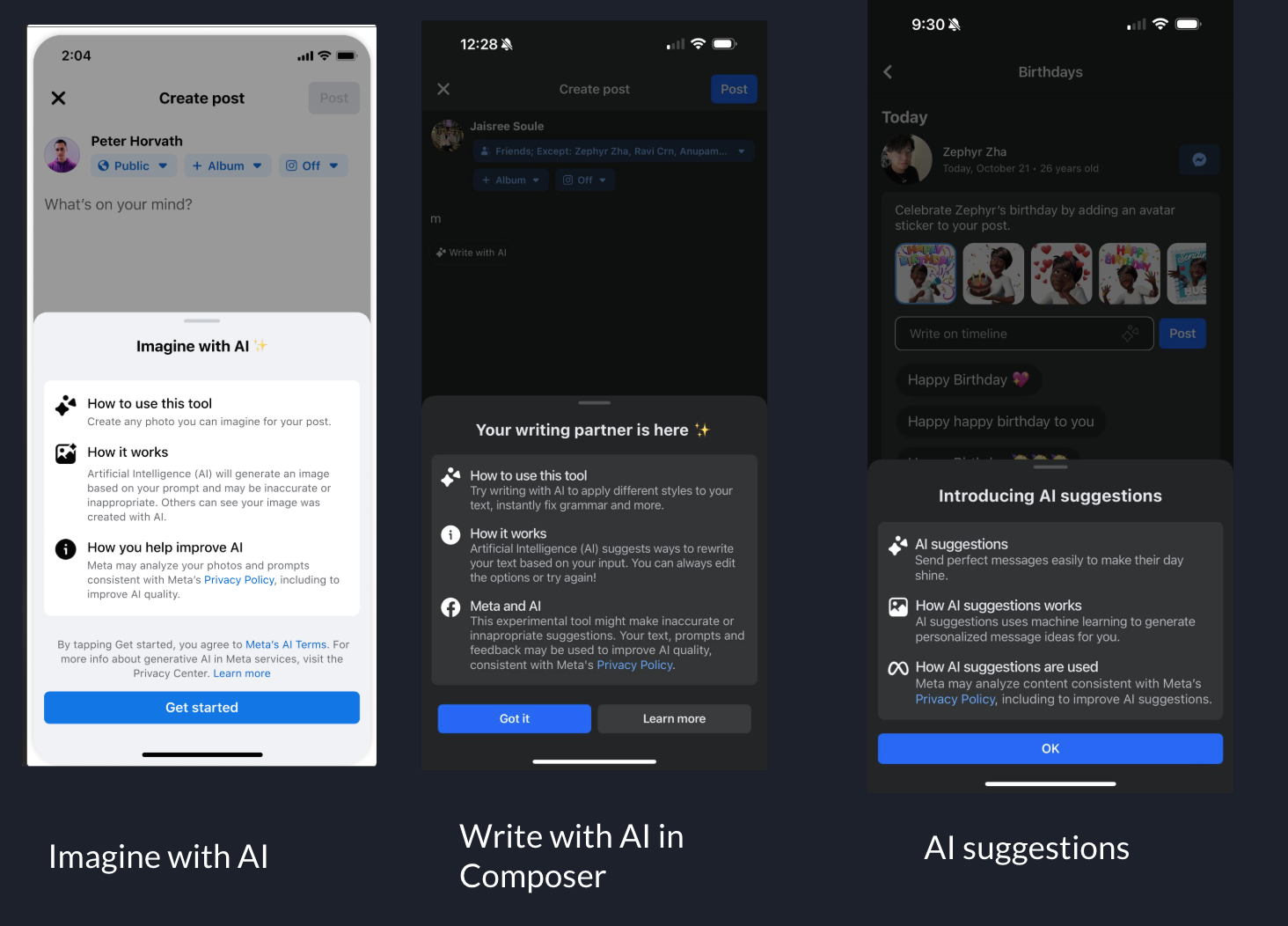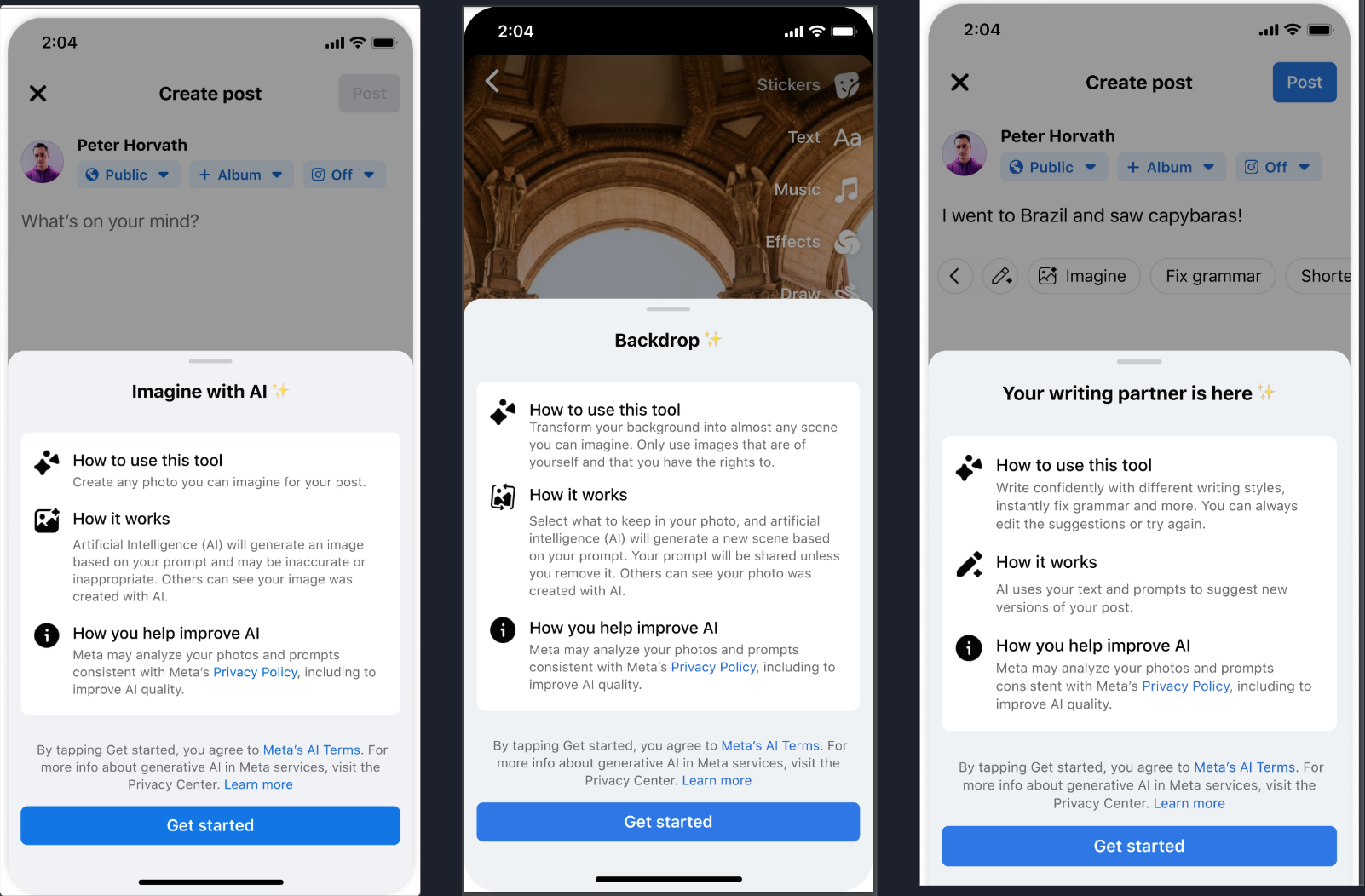Designing AI onboarding that scales — and puts users first
Starting from uncertainty
To ground the work, I:
-
Partnered with other content designers—reviewing their explorations in Figma, exchanging feedback, and learning from shared approaches.
-
Researched across Facebook Workplace groups to surface insights on AI and onboarding patterns.
-
Collaborated with researchers and cross-functional partners across FoA.
-
Participated in AI workshops to deepen context and stay aligned with evolving product direction.
-
Developed an early tonal framework that later shaped headers and value propositions across all AI workstreams.
Move fast, but don't break things
Turning content strategy into design impact for AI Features
-
I partnered with 5–6 designers from the concept phase across five major AI workstreams—stickers, backgrounds, writer, captions, and Imagine. To stay integrated without slowing design, I built dedicated content design playgrounds in Figma, mirrored explorations, and contributed early ideas. This ensured transparency, accelerated feedback loops, and kept strategy aligned across teams.
I developed and tested multiple onboarding flows (bottom/half-sheets, tooltips, toasts, disappearing messages) and mapped entry points across the product to identify high-impact content moments. My contributions turned abstract strategy into tangible design artifacts—wireframes, journey maps, and prototypes—that shaped early critiques and aligned Facebook and Instagram CDs on a unified AI approach.
User mindset was a guiding principle. Recognizing that many were engaging with AI for the first time, I:
-
Advocated for progressive disclosure (“Write with AI” surfaced only once typing began).
-
Replaced error toasts with contextual suggestions to reduce blame.
-
Designed flows that encouraged experimentation over abandonment.
By framing challenges in crits and surfacing solutions early, I helped teams move past roadblocks faster and scale design decisions that made AI approachable, useful, and trustworthy.
-
Unified onboarding content strategy
- While I can't share the actual billboards, I can show examples of what we tested.
- I constantly refined our approach based on research and data, eventually creating a content standard and playbook with specific guidance.
- Content guidance such as: Clear Do's and Don'ts - like always using "AI" (not "Ai," "ai," or even "Artificial Intelligence").
- I shared my playbook draft and invited other content designers to weigh in. I wanted to make sure it actually worked for our teams—and that it reflected the voices of other folks working in AI content design, not just mine.
- Clear content structure: Clear header followed by 3 bullets explaining what the tool does, how to use it, and what it means for their experience and privacy with 1 primary CTA "Get started"
- With my proposed strategy, whenever users triggered a bottomsheet, they'd see the same clear bottomsheet design.
- Teams across the organization like Groups and Dating could easily adopt these standards in their onboarding experience.
- The goal was consistency and reducing friction in the experience with multiple different components and overwhelming users.


Wrapping it up with wins
-
Created Facebook’s first AI content standards and playbook, rooted in research and real user behavior.
-
Established clear, reusable content patterns—including structured bottomsheet components with consistent headers, value props, and CTAs—to reduce friction and build trust.
-
Defined guidance like using “AI” (not “Ai,” “ai,” or “Artificial Intelligence”) to ensure clarity and alignment across surfaces.
-
Made the playbook collaborative and inclusive, inviting other AI content designers to contribute and shape the guidance together.
-
Enabled consistency across the org, making it easy for teams like Groups and Dating to apply the same high-quality content patterns in their onboarding experiences.
-
Continuously evolved the strategy based on research insights and testing—from early concepts to finalized, scalable standards.
- Increased original content creation in stories and composer (although I can't share that sensitive metrics)
Key stakeholders
- Multiple project managers
- User researchers
- Product designers
- Engineering team/data scientist team
- Privacy and legal teams
